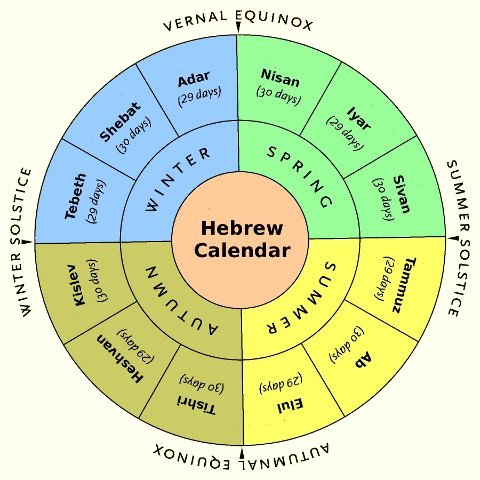
by John P. Pratt
2 Dec 2014, 1 Birth (V)
©2014 by John P. Pratt. All rights Reserved.
| 1. Event Dates |
| 1.1 Christ |
| 1.2 Adam |
| 1.3 Mary and Rachel |
| 1.4 John the Baptist |
| 1.5 The Flood Begins |
| 1.6 Old Testament Dates |
| 1.7 Latter-day Events |
| 2. Decision Dates |
| 2.1 Josiah Reads the Law |
| 2.2 Liberty Proclaimed |
| 2.3 116 Pages |
| 2.4 High Priests |
| 3. Conclusion |
| Notes |
Last week the newly discovered Uniform Hebrew (UH) Calendar was described in detail.[1] This article summarizes several witnesses it provides of key religious dates in history. For this article, all that is needed to know is that the UH calendar is very similar to the traditional Hebrew Calendar, with the same month and year lengths and holy days. Like all uniform calendars, has a fixed pattern that it follows all through history. It never inserts an extra day: its 33-year cycle is always the same even though individual years vary in length, and every third year has a thirteenth month inserted. The basic pattern for the year is shown in Figure 1.
 |
Now let's turn to what can be learned from this new UH Calendar. As all of the events are considered, it appears that this calendar is not used much for birth dates of great religious figures. Instead it is used to highlight other sacred events such as the Fall of Adam, the Great Flood, and the Resurrection of Jesus Christ. There are so many correlations to the three holy days called "Decision Days"[2] that an entire section of this article focuses just on them.
Unless otherwise stated, all event dates presented were proposed in previous articles. Rather than give all of the exact dates on the Gregorian Calendar, each date can be looked up on the Religious Chronology page of my website. It provides a link to the articles in which that date was discussed.
 |
Table 1 shows how the already proposed dates for key events in the life of the Savior occur on holy days on the Uniform Hebrew Calendar. Dates on the secondary UH Calendar are labeled (2). All dates listed are on holy days. The ones shown in red are where the significance of the holy day exactly matches the event, such as the Resurrection occurring on Easter, the holy day designed to celebrate the Resurrection.
The list of events in Table 1 closely matches the events that have been discussed at length in previous articles. They nearly all occur on holy days on several sacred calendars. In these cases, the UH calendar provides yet another witness of their importance. One such date is that of the visit of the magi, which is holy on so many calendars that it testifies that their visit was not a random event.
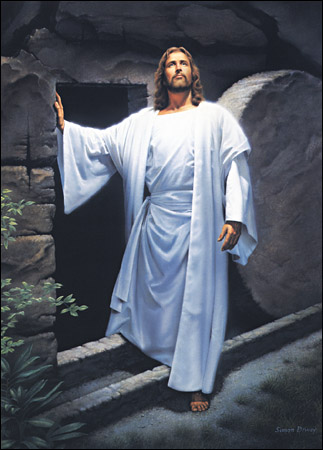 |
There are many red letter days, which means perfect symbolism of holy days to events during the life of Jesus. His baptism is right for the day of Atonement, the day to be reconciled to God. The day labeled "Eat My Flesh" was when he first introduced the concept of the sacrament of the Lord's Supper, which is tied directly to the death and resurrection of Christ celebrated at Easter. The Transfiguration is another example of becoming one with God (At-one-ment). The entire symbolism of the Passover at the Exodus was about freeing slaves from prison, which is what Jesus did at the Passover on which he visited the Spirit World. And of course the Resurrection on Easter is a perfect match.
Thus we see that nearly all of the key events of the Savior's life discussed in other articles were also holy days on the Uniform Hebrew Calendar.
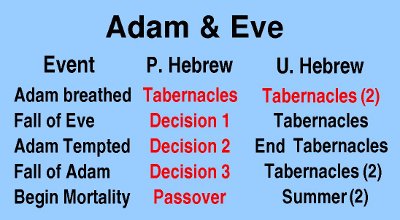 |
The second column lists dates on the Perpetual Hebrew Calendar (PH), a corrected long-term form of the Hebrew Calendar. It is actually tied to the seasons: Tabernacles occurs in the autumn and Passover in the spring. The proposed dates of the three events of the Fall of Eve and Adam all happened on the three "Decision Days," which each occur one week after the other in the summer. They are called in my work Decision 1, Decision 2, and Decision 3. The events listed in the first column are "Fall of Eve," referring to the day on which she partook of the fruit, "Adam Tempted" when Eve told Adam what she had done and invited him to follow her lead rather than God's commandment, and "Fall of Adam" when he did so and also partook of the fruit. Those are three of the biggest decisions in history and years ago it was proposed that each occurred on one of the three Decision Days (PH).[3]
The date on which Adam first breathed the breath of life is in red because the Feast of Tabernacles symbolized birth, when we come to earth to get our tabernacle to live in.
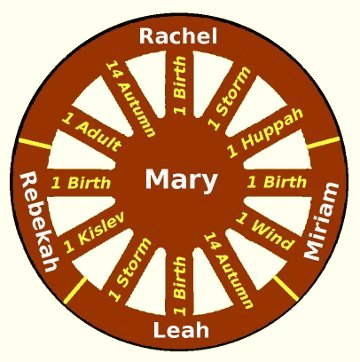 |
The birth and death dates of John the Baptist on this calendar are also worth mentioning because they illustrate another use of uniform calendars. Many years ago the birth date of John the Baptist was proposed as being on the Day of Atonement on the Perpetual Hebrew Calendar. Until this article, it was known to be on either the afternoon or evening of Wed 6 Oct 2 BC. That was known better than the details of the Perpetual Hebrew Calendar.
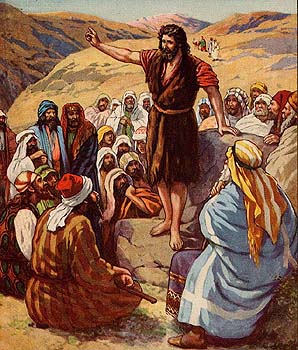 |
The Easter version of the Uniform Hebrew Calendar provides a witness to which choice is correct. Wednesday afternoon was still 1 Elul (UH). Being the first day of a month, that is a minor holy day. For John it has important symbolic meaning. That holy day represents becoming one with God. John was entrusted with the huge mission of preparing the way for the Lord's first coming. He could be considered one with the Lord even during this lifetime.
The witness that John's birth date on that UH calendar was not just a random coincidence is that his death date on that same calendar occurred on another holy day on that calendar: the Feast of Tabernacles (UH). It has been shown in several other papers that the interval from his birth to death is amazing in that both vital dates fall on holy days on several planetary calendars. Thus, his dates have been locked in as anchor dates of history, but the ambiguity between afternoon and evening of his birth date had not been resolved.
This example illustrates the power of the uniform calendars because no "leap days" are ever added to change the fixed pattern. Thus the uniform calendars can help resolve borderline cases of the normal calendars.
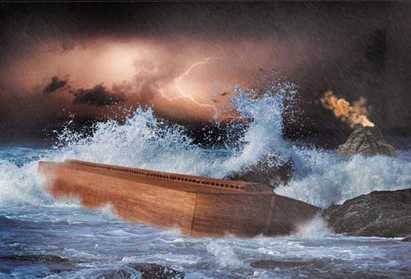 |
Two of the most important dates of the Deluge have been dubbed Noah's Ark Day and Deluge Day in my work. The first was when the ark began to be loaded one week before the rain began. The second is the actual beginning date of the rain. On the Hebrew Calendar neither date is singled out in the law of Moses as a holy day.
In earlier papers Noah's Ark Day has overshadowed Deluge Day because of its many links to other dates in history. But that day is hardly mentioned in the Bible. There the important date is Deluge Day, when the forty days of rain began to fall.
Deluge Day, when the Flood actually began, is not particularly illustrious on the sacred calendars. It is a minor holy day on a few calendars, but nothing spectacular like Noah's Ark Day. The only major holy day it occurred on was the Beginning of Watering on the Jubilee Calendar, which is a bull's-eye. Now it turns out that it is the Feast of Tabernacles (UH), which is the most important feast of the year. That provides an excellent second witness to the accuracy and significance of that day.
There are several key events from the Old Testament which occurred on meaningful holy days on the UH Calendar.
The date of the giving of the Ten Commandments in the first year of the Exodus was certainly a key date. Traditional Judaism puts the event on the Feast of Firstfruits, which has been verified in my work (PH). Now we have an added witness of the correctness of the proposed date in that it was on Passover (UH2). That seems like a bull's-eye in that this was the year for which Passover is named. In other words, during the year of the Exodus, the one day on which Passover (which commemorates the Exodus) occurs is the day of the giving of the Ten Commandments. Moreover, the day on which Moses ascends the mountain for his first 40-day interval began on the Last Day of Passover (UH2).
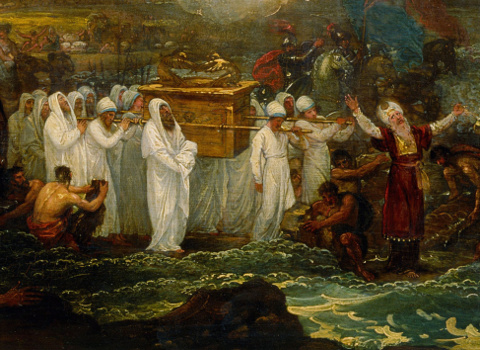 |
Now the UH Calendar provides a strong second witness of the Saturday date because it was also Consecration (UH2) on that calendar. So it was not only a holy day, but it was the exact same day on the calendar of Moses. The UH calendar rotates around through the seasons once in about 300 years, so this is a rare occurrence to have the two calendars precisely align.
Like all of the other proposed event dates mentioned so far, the birth date of David was proposed over a decade ago. That day now turns out to be the Day of Atonement (UH2). The day Daniel was taken captive to Babylon was Passover (UH2). After the Babylonian captivity, when the Jews were allowed to return to Jerusalem to rebuilt their temple, the feast of Tabernacles which they held was on the Day on Atonement (UH). Each of those dates are not just on random holy days, but rather on one with significant symbolism. For example, Atonement is the day to make reconciliation with God, which they had done after the seventy-year captivity. All of the dates were proposed based on entirely independent evidence, so the UH Calendar provides a legitimate second witness to them.
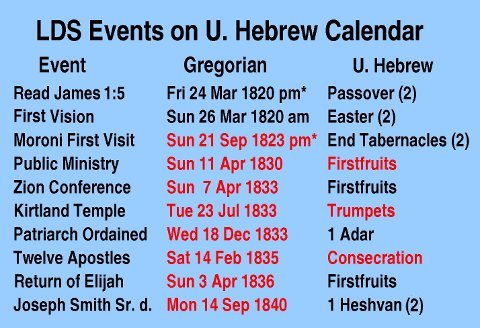 |
The date of the Prophet Joseph's reading of James, which led him to pray for guidance, is not recorded in LDS history. More importantly, the date of the First Vision shortly thereafter when Joseph later reported seeing God the Father and Jesus Christ is also not known from official records.
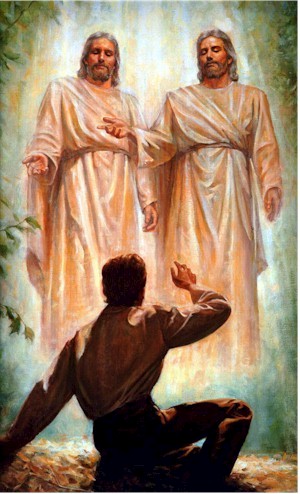 |
Now confirming evidence comes for both dates. The proposed date for the reading of James 1:5 was the beginning of Passover (UH2). So it was a holy day on both the Hebrew and U. Hebrew calendars. Moreover, the proposed date of the First Vision was Easter Sunday (UH2). Those are two of the most sacred holy days.
The Prophet Joseph records that on the evening of 21 Sep 1823 that he prayed (JS-H 1:27, 29), after which an angel appeared to him and told him about the golden plates from which he would translate the Book of Mormon. The next day he found those plates in the place he had been shown. In all my work on sacred calendars those two events have not shown up as a holy day until now. Both the evening and the subsequent day were the holy day of the Last Day of Tabernacles (UH2), also referred to as the "Great Day of the Feast". Thus, the Uniform Hebrew Calendar witnesses an important date which other sacred calendars could not do. There are so many events, and each calendar can only do just so much.
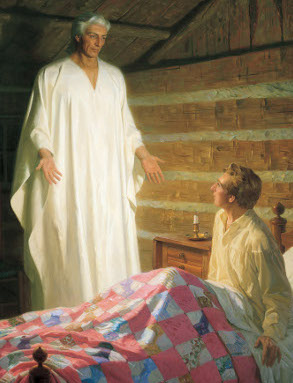 |
Another important date occurred three years later again on Easter Sunday, 7 Apr 1833, at the conference of the church held in Zion (Independence, Missouri). Again that date was Firstfruits (UH).
Two events happened on Tue 23 Jul 1833. In Independence, Missouri, the saints were forced to agree in writing to leave the state. On that very same day in Kirtland, Ohio, the cornerstone of the temple there was laid. Those two events seem linked because one of the reasons for their expulsion from Missouri was that they had failed to fulfill the commandment to build the temple there. Accordingly, they made great efforts to complete the Kirtland temple so it could be dedicated in time for the important return of Elijah.
That double event day was the Feast of Trumpets (UH). That is another bull's-eye because that day is a "beginning" day, when projects are either announced (as with trumpets) or actually started. Thus it is listed in red in the table as fitting both the beginning of the temple as well as the beginning of their (first) exit from Missouri.
Another important date is the ordination of the first patriarch of the LDS Church: Wed 18 Dec 1833. It seems unusual that such a holy ordination would not have been done on a sabbath day, but it has turned out to be on a holy day like unto when the ancient patriarchs were ordained. Now another witness comes forth, that it also occurred on the new month holy day 1 Adar, the first day of the twelfth month.
Another red-letter day was the date of ordaining the newly called Quorum of Twelve Apostles on Sat 14 Feb 1835. That day turns out to have been "Consecration" (UH). As explained above, that is the day for choosing and ordaining holy men, so it is counted as a bull's-eye in red letters in the table.
 |
Note that the three Firstfruits (UH) dates listed in the table were all also Easter (Gregorian and Hebrew). They are a great example of how the Hebrew Calendar works. The Christian Easter turns out (not by Nicene Council design) to nearly always coincide with the Hebrew Easter. As was discussed in the last article introducing the UH Calendar, it is based on sets of three years, after which it sometimes repeats. The repeating usually occurs four days earlier on the Gregorian Calendar. This is an example. The dates of Easter are four days earlier after three years (11 Apr, 7 Apr, 3 Apr) and they are all the same holy days on both the Hebrew and UH Calendars. On the Hebrew Calendar, when the holy days would occur too early in the year, the calendar jumps to a new starting point to keep in sync with the seasons. On the other hand, the UH Calendar just continues and the holy days keep coming about 4 days earlier every three years.
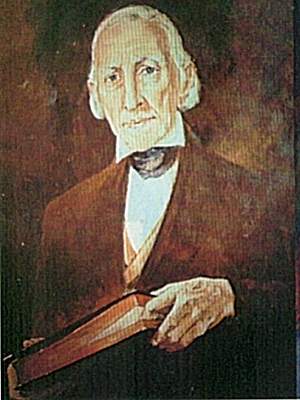 |
Thus, many key dates of the latter-day restoration occurred on significant holy days on the Uniform Hebrew Calendar. That is a witness of their importance, and of their holy status. That so many of the key dates fell on holy days of the Uniform Hebrew Calendar is far beyond chance and is a witness of the correctness of that calendar as well as the foreknowledge of God.
There are three holy days in the summer on the Hebrew Calendar which are appear to be especially dedicated to the making of important decisions. The first is a fast day and is called in the scriptures simply the "fast of the fourth month". It occurs on the 17th day of that month (Tammuz). At the end of the three week period comes "the fast of the fifth month" (9 Ab) which appears to be a day on which the results of the decision(s) begin to be manifest. That day tends to be a day of mourning because often the decisions led to death rather than life.
In previous papers these days have simply been called "Decision Days". Now it seems well to give each a specific name, so 17 Tammuz will be called "Decision 1", 24 Tammuz is "Decision 2", and 2 Ab is "Decision 3".
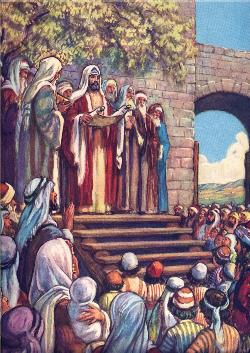 |
There has been a tentative proposed date for that reading in my research database for many years, but it has not been certain enough to publish. That date is Sat 3 Oct 623 BC. That day was the Feast of Tabernacles (PH), the day specified for the reading of the law. It was not in what now appears to be the correct sabbath year that comes every seventh year, but the history does not say he waited for that year. It does appear to be in the eighteenth year of his reign which is what is specified.
That day was also Tabernacles on the Enoch Calendar and the Last Day of Tabernacles on the Jubilee Calendar, as well as holy on three other sacred calendars. Now comes the added witness that tipped the scales for me to publish it. The day was also Decision Day 2 (24 Tammuz) on the Uniform Hebrew Calendar. That is a bull's-eye because Josiah decided to covenant publicly to obey the law on that day.
This is an example of how useful a uniform calendar can be. On the seasonal calendar, the correct time for reading the law is at Tabernacles in the autumn. The decision days all occur in the summer. But on a uniform calendar which rotates around through all of the seasons, Tabernacles can be designated as a Decision Day.
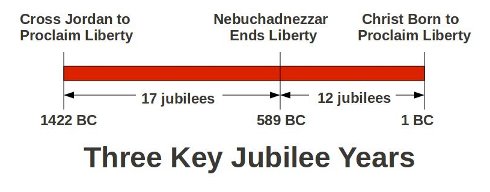 |
Afterward, the prophet Jeremiah received a revelation saying that because they had failed to proclaim liberty, that now He would proclaim liberty in his own way:
Ye have not hearkened unto me, in proclaiming liberty, every one to his brother, and every man to his neighbour: behold, I proclaim a liberty for you, saith the Lord, to the sword, to the pestilence, and to the famine;" -- Jer. 34:17
The jubilee year formally begins when it is declared on the Day of Atonement in the autumn. The first day after the end of that year would be Atonement of the following year. That day began after sunset on Fri 11 Sep 589 BC. That was a holy day on several calendars and has been a tentative candidate in my research to be the date of that revelation. The revelation ended by saying that Nebuchadnezzar would return to destroy the city, and that siege began three months later.[9]
Now there is an added witness from the Uniform Hebrew Calendar which seems to tip the scale to make that proposed date for the revelation to Jeremiah worth publishing. It was also Decision Day 2 (UH). That seems like a bull's-eye because God is announcing His decision to proclaim liberty in His own way.
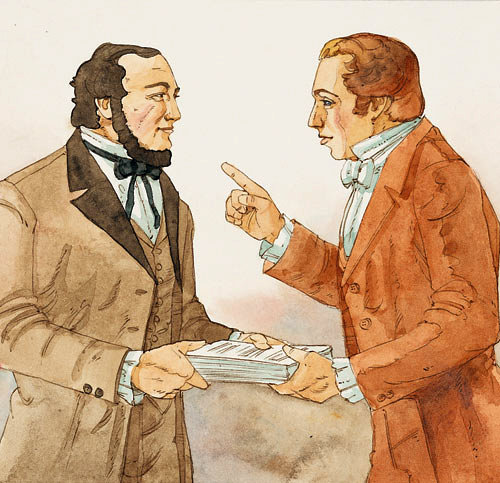 |
In my earlier papers, one date related to this incident was found to have occurred on holy days. The day proposed for Martin Harris's decision to tell Joseph that he had lost the manuscript, Tue 8 Jul 1828, was a Decision Day on both the Hebrew and Enoch Calendars.[10]
It had appeared strange at the time of writing those articles that the day of the earlier decision to even let Martin take the pages at all did not show up on any sacred calendar as a decision day. Now that gap is filled. The evening of 14 Jun 1828 began Decision Day 2 (UH). That is a bull's-eye because it was a huge decision made on a Decision Day. Moreover, it occurred on a date given precisely in history. Even the evening time is implied because the Prophet's mother states that Martin left shortly before the birth of Joseph's son, which was on Sunday, 15 Jun 1828.
It could also be that a second decision was made that next day (Sun 15 Jun 1828), which was the same UH day. How long would Martin have waited to show the manuscript to his importuning wife? He most likely showed her on that very day, and may have also chosen to break his covenant by showing it also to people beyond those to whom he had been given permission to view the pages. It was a time of great decisions indeed, which have affected the world unto this day because the first 116 pages of the Book of Mormon were lost and never recovered.
There is another important date in LDS history that is often overlooked, and which has not yet been mentioned in my articles. It is the date of the ordination of the first High Priests after the order of Melchizedek: Sat 4 Jun 1831. There was a quarterly conference of the Church that weekend.
Until that day, the highest priesthood office in the church had been an elder. Joseph was referred to as the First Elder of the church. Later, when the quorum of the First Presidency would be organized in 1832, all three men would need to be high priests. In fact, the First Presidency of the Church is designed to be the presidency of the High Priesthood (D&C 107:22). The Quorum of Twelve Apostles would not be organized until 1835.
 |
Several were then selected by revelation, through President Smith, and ordained to the High Priesthood after the order of the Son of God; which is after the order of Melchizedek. This was the first occasion in which this priesthood had been revealed and conferred upon the Elders in this dispensation, although the office of an elder is the same in a certain degree, but not in the fulness. On this occasion I was ordained to this holy ordinance and calling by President Smith.[11]
Levi Hancock, also present, added:
The Fourth of June came and we all met in a little string of buildings under the hill near Isaac Morley's in Kirtland, Geauga County, Ohio. Then we all went to a school house on the hill ...
Joseph Smith then stepped out on the floor and said, "I now see God, and Jesus Christ at his right hand, let them kill me, I should not feel death as I am now." ...
Joseph Smith called Lyman Wight and laid his hands on his head and say what God should tell him to say. He did and the blessing was so long I cannot write it.[12]
This latter quote is included to show the exact day of the ordinations because the conference was called on Fri 3 Jun and lasted until Sun 5 Jun or Mon 6 Jun. It also testifies that great visions were manifest on that occasion.
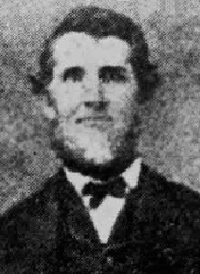 |
Thus, the day was a very holy day, with many spiritual manifestations. The day, however, has not yet been mentioned in my articles because it was not holy on several calendars, as might have been expected. But now the day Sat 4 Jun 1831 turns out to have been Decision Day 1 (UH). To me that makes it worth publishing because besides being a holy day, the fact that it was a Decision Day might be very symbolic and meaningful.
What sort of decision might have been involved with these men being ordained high priests? For one thing, many present testified of both good and evil spiritual manifestations, and decisions had to be made concerning them. Joseph was given the ability to discern between them correctly, whereupon he chose the good and cast out the evil. Moreover, when one studies subsequent events, it seems clear that other decisions were made by the recipients about what they would do with this high and holy calling.[13]
Another sacred calendar holy day might be significant here. The afternoon of that day was the day 1 Malchijah, a holy day on the Priest Calendar. Note the similarity of that name to Melchizedek. Malchijah means "King of (appointed by) Jehovah" and Melchizedek is "King of Righteousness". That is the day on the Priest calendar which corresponds to Melchizedek. It was the day which has been proposed in my articles for the ordination of Noah. So that day also appears to be a bull's-eye on the Priest Calendar.
That day was the Last Day of the Grain Harvest and the next day (Sunday 5 Jun) was Firstfruits of Wine on the Jubilee Calendar. On the day after the conference many men were called to go on missions (D&C 52), appropriate for the first day of their working in the Lord's vineyard, clothed with greater priesthood authority.
Many important key religious event dates in history fell on holy days on the Uniform Hebrew Calendar. These include the most important events of history, such as those of the atonement and resurrection of Jesus Christ, as well as the Fall of Adam and Eve. In additional to several dates from the Old and New Testaments, there were also several key events of the restoration of the latter-day Church that occurred on such holy dates. In particular, this calendar is a witness of some dates which have been uncertain, such as the date of the First Vision. The number of times that such important events occurred on Uniform Hebrew Calendar holy days is far beyond chance and provides a compelling witness of the accuracy both of the dates and also of the calendar. Altogether, it provides a powerful testimony of the Creator.